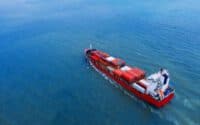Big 5 Breakdown: Size, Fuel Burn, and Carrying Capacity

The backbone of global trade, these colossal vessels are more than just structures of steel and engine; they are moving cities, powerhouses of the sea, each with their own unique story. From the fuel-laden tankers to the container-stacked giants, we give you a quick rundown of the ‘Big 5’ in the shipping industry – Tankers, Bulk Carriers, Ro-Ro Ships, Container Ships, and General Cargo Ships. Let’s go!
* Please send feedback/suggestions to editor @ shipuniverse.com
Tankers
Bulk Carriers
Ro-Ro Ships
Container Ships
General Cargo Ships
Tankers – Masters of Liquid Cargo
Tankers, the titans of liquid transport, come in a variety of sizes, each uniquely suited for different needs and navigational routes. Let’s dive into the details:
The Many Faces of Tankers
Tankers, the titans of liquid transport, come in a variety of sizes, each uniquely suited for different needs and navigational routes. Let’s dive into the details:
Handy and MR Tankers: Agile and Versatile
- Handy Tankers: These nimble vessels typically carry up to 50,000 deadweight tonnage (DWT). Ideal for shorter routes and smaller ports, they’re the go-to for quick and efficient transport.
- MR (Medium Range) Tankers: A step up in size, MR tankers handle about 55,000 DWT. They strike a balance between capacity and accessibility, making them a popular choice in the industry.
- Fuel Consumption: On average, Handy and MR tankers consume about 20-35 tons of fuel per day, depending on their age, condition, and operational speed.
LR (Long Range) Tankers: The Middleweights
- LR1 Tankers: These are the smaller of the long-range vessels, with capacities ranging from 55,000 to 79,999 DWT.
- LR2 Tankers: Falling in the upper segment, they carry 80,000 to 120,000 DWT. Both LR1 and LR2 are known for their versatility, able to access a wider range of ports than their larger counterparts.
- Fuel Consumption: LR1 tankers typically consume between 25 and 40 tons of fuel per day, while LR2s can go up to 40-50 tons daily.
VLCC and ULCC: The Heavyweights
- VLCC (Very Large Crude Carriers): These massive vessels can carry up to 320,000 DWT. They’re the workhorses for long-distance, large-volume liquid transport.
- ULCC (Ultra Large Crude Carriers): The giants of the tanker world, ULCCs can handle an incredible 500,000 DWT, but their size limits the ports they can access.
- Fuel Consumption: A VLCC can consume about 55-85 tons of fuel per day. The colossal ULCC, on the other hand, can gulp down over 100 tons daily, depending on factors like load, speed, and sea conditions.
Bulk Carriers: From Handy to Heavyweight
Bulk carriers, the behemoths of dry cargo transport, are classified into several categories based on their size and capacity. This categorization ensures they can efficiently navigate through various ports and waterways, fulfilling diverse cargo needs. Let’s unpack these categories:
Handysize: The Versatile Players
- Size: Smallest in the bulk carrier family, typically 15,000 to 35,000 deadweight tonnage (DWT).
- Roles: Known for flexibility and access to smaller ports. Ideal for various cargo types.
- Capacity: Carries a range of commodities, from steel products to grains and minerals.
- Fuel Consumption: Approximately 20-25 tons of fuel per day. These ships are more fuel-efficient due to their smaller size and shorter routes.
Handymax/Supramax: The Balanced Middle
- Size: Slightly larger, generally 35,000 to 60,000 DWT.
- Advantages: Offer a good balance between capacity and flexibility. Can access a wider range of ports.
- Capacity: Well-suited for bulk commodities like grains, coal, and minerals.
- Fuel Consumption: Consumes around 25-30 tons of fuel per day. Efficiency varies based on load and distance traveled.
Panamax: The Canal Specialists
- Size: Designed to fit through the Panama Canal, typically 65,000 to 80,000 DWT.
- Significance: Maximizes the size limit of the Panama Canal. Efficient for specific trade routes.
- Capacity: Commonly used for grains, coal, and other bulk commodities.
- Fuel Consumption: Around 30-35 tons of fuel per day. Efficiency depends on factors like canal navigation and cargo weight.
Capesize: The Ocean Giants
- Size: Exceeds Panamax limits, over 80,000 DWT, often up to around 180,000 DWT.
- Role: Named for navigating around Cape Horn or the Cape of Good Hope. Too large for the Panama and Suez Canals.
- Capacity: Specializes in very large loads, like iron ore and coal, for long-haul trips.
- Fuel Consumption: The largest in the bulk carrier family, consuming 40-50 tons of fuel per day. These vessels prioritize cargo volume over fuel efficiency.
Ro-Ro Ships: Masters of Wheeled Cargo
Roll-On/Roll-Off (Ro-Ro) ships, with their unique design and functionality, play a pivotal role in global maritime transport, especially for wheeled and heavy machinery cargo. Let’s take a closer look at these versatile movers on the seas.
Small Ro-Ro Vessels: Agile and Efficient
- Size: Generally under 150 meters in length. Designed for short sea routes or inter-island services.
- Roles: Ideal for transporting smaller volumes of cars, trucks, and heavy equipment within a regional scope.
- Capacity: Varying amounts of wheeled cargo, typically offering a few hundred to a couple of thousand lane meters.
- Fuel Consumption: Relatively fuel-efficient, consuming approximately 15-25 tons of fuel per day, depending on operational factors.
Mid-Size Ro-Ro Ships: The Versatile Workhorses
- Size: Typically ranging from 150 to 200 meters in length. Designed for longer coastal and international routes.
- Roles: Suitable for larger volumes of cars, commercial vehicles, and heavy machinery, with increased deck space.
- Capacity: Offers a substantial increase in lane meters, often accommodating thousands of cars.
- Fuel Consumption: Consumes around 30-45 tons of fuel per day, influenced by the route and load.
Large Ro-Ro Ships: The Long-Haul Giants
- Size: Among the largest in the Ro-Ro category, often exceeding 200 meters in length. Designed for major international shipping routes.
- Roles: Primary choice for massive volumes of vehicles and heavy equipment for long-distance travel.
- Capacity: Highest lane meter capacity, often exceeding 5,000-7,000 lane meters, equating to 2,500 to 4,000 medium-sized cars.
- Fuel Consumption: The highest in the Ro-Ro category, ranging from 40-60 tons of fuel per day, depending on the voyage’s specifics.
Container Ships: The Pioneers of Global Trade
Container ships revolutionized the shipping industry by standardizing cargo transport, making them a key player in global trade. Let’s delve into the specifics of these maritime giants.
Small Feeder Ships: The Regional Connectors
- Size: Typically under 150 meters in length.
- Roles: Essential for moving container cargo between small ports and larger container hubs.
- Capacity: Can carry a few hundred to a thousand twenty-foot equivalent units (TEUs).
- Fuel Consumption: Generally, consume less fuel compared to larger container ships, about 20-30 tons per day, depending on the route and speed.
Panamax Container Ships: The Canal Navigators
- Size: Designed to fit through the Panama Canal, usually about 290 meters in length.
- Roles: Optimized for routes that require transit through the Panama Canal.
- Capacity: Typically carry between 3,000 to 5,000 TEUs.
- Fuel Consumption: Consumes around 40-50 tons of fuel per day. Efficiency depends on load and voyage specifics.
Post-Panamax and New Panamax: The Larger Workhorses
- Size: Larger than Panamax vessels, ranging from 300 to 366 meters in length.
- Roles: Suited for high-volume trade routes that don’t require canal transits.
- Capacity: Carrying capacity ranges from 5,000 to 14,000 TEUs.
- Fuel Consumption: Fuel consumption varies significantly, typically between 50-100 tons per day, based on size, cargo, and operational speed.
Ultra Large Container Ships (ULCVs): The Behemoths of Trade
- Size: Among the largest in the container ship category, often exceeding 400 meters in length.
- Roles: Designed for the busiest long-haul trade routes, mainly between Asia, Europe, and North America.
- Capacity: Can carry over 18,000 TEUs, with some even exceeding 20,000 TEUs.
- Fuel Consumption: The largest consumers of fuel in their class, often exceeding 100 tons per day, but offer improved efficiency per TEU.
General Cargo Ships: The Jacks-of-All-Trades in Maritime Transport
General Cargo Ships, known for their versatility, play a crucial role in shipping a variety of goods that aren’t suitable for bulk or container transport. Let’s explore their categories and specifics.
Small General Cargo Ships: Local Workhorses
- Size: Generally under 100 meters in length.
- Roles: Perfect for short sea routes and smaller ports, often used for transporting a mix of cargo types including heavy machinery, lumber, and packaged goods.
- Capacity: Typically carry up to a few thousand tonnes of cargo, with deck space and holds adaptable to different cargo types.
- Fuel Consumption: Relatively low due to their smaller size, consuming around 10-20 tons of fuel per day, based on route and cargo load.
Multi-Purpose Ships: The Flexible Movers
- Size: Ranging between 100 to 150 meters in length.
- Roles: Designed to handle a wide range of cargo types, including break-bulk, containers, and even liquid cargo in specialized tanks.
- Capacity: Can carry more varied cargo compared to small general cargo ships, often equipped with cranes and other gear for handling heavy loads.
- Fuel Consumption: Moderate, consuming around 20-30 tons of fuel per day, influenced by cargo weight and journey distance.
Heavy-Lift Ships: The Heavy-Duty Specialists
- Size: Similar in size to multi-purpose ships but built sturdier, often around 100 to 160 meters.
- Roles: Specialized in transporting unusually heavy or oversized items like large machinery, industrial parts, and yachts.
- Capacity: Equipped with heavy-duty cranes and reinforced decks, they are designed for loads that other cargo ships can’t handle.
- Fuel Consumption: Consumption is higher due to the heavy loads, often ranging from 30-40 tons of fuel per day.

Do you have any feedback or additional insights? Please reach out to editor @ shipuniverse.com



